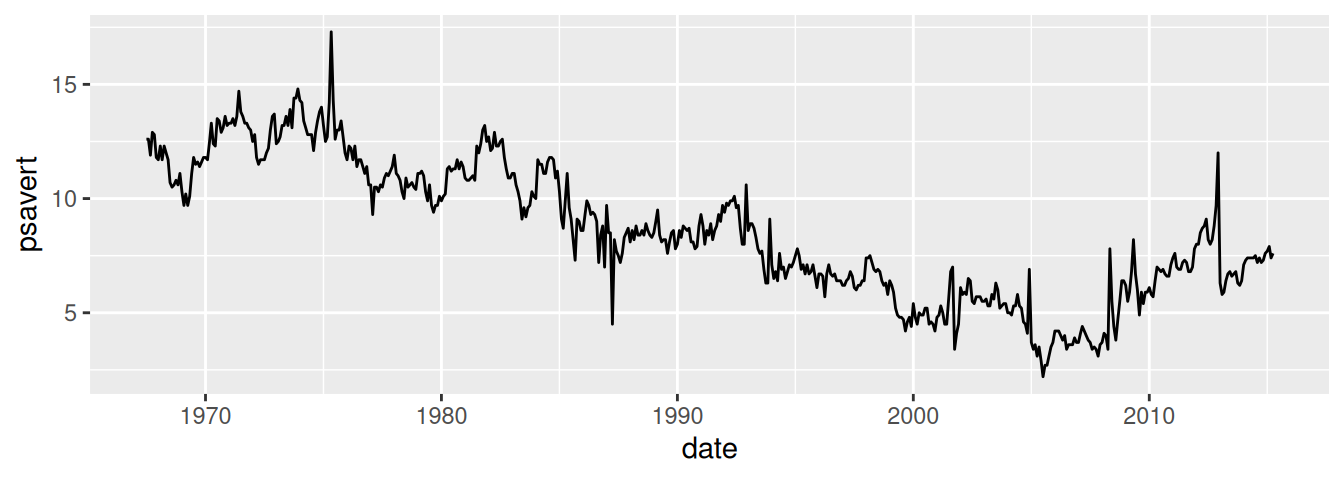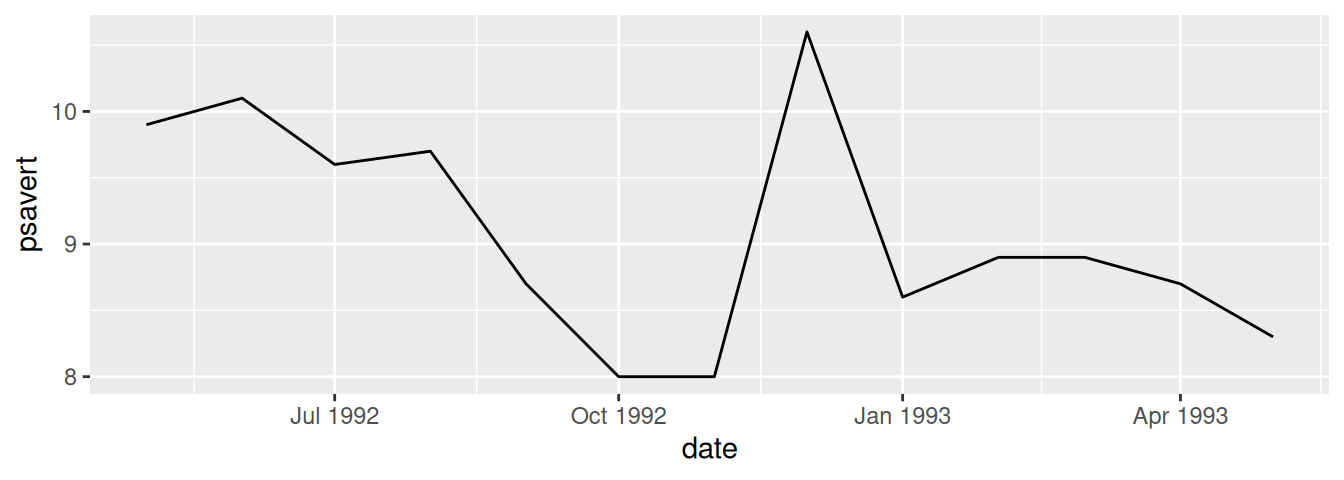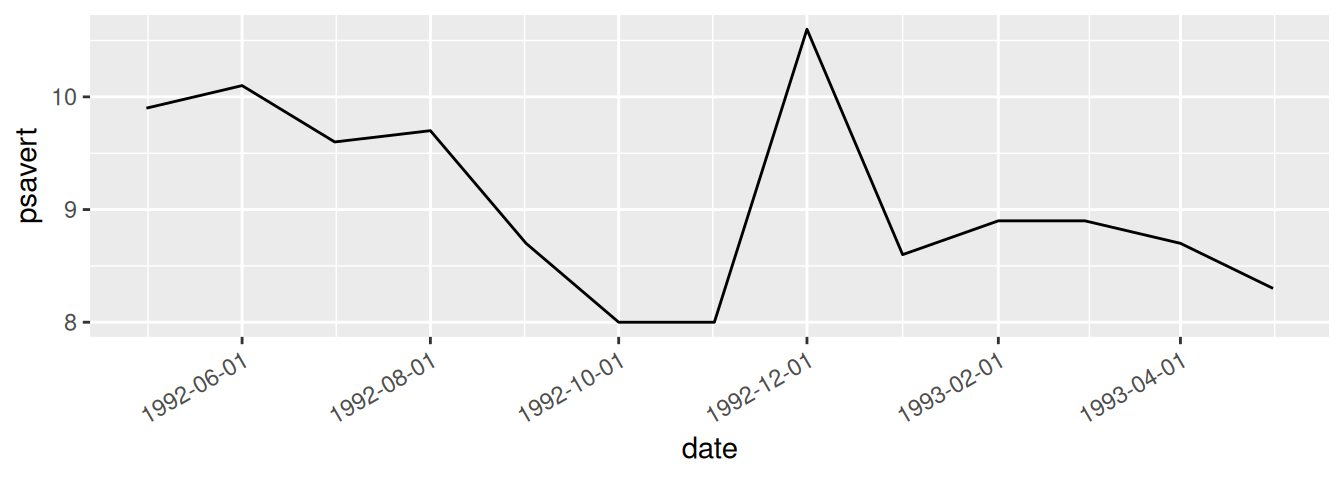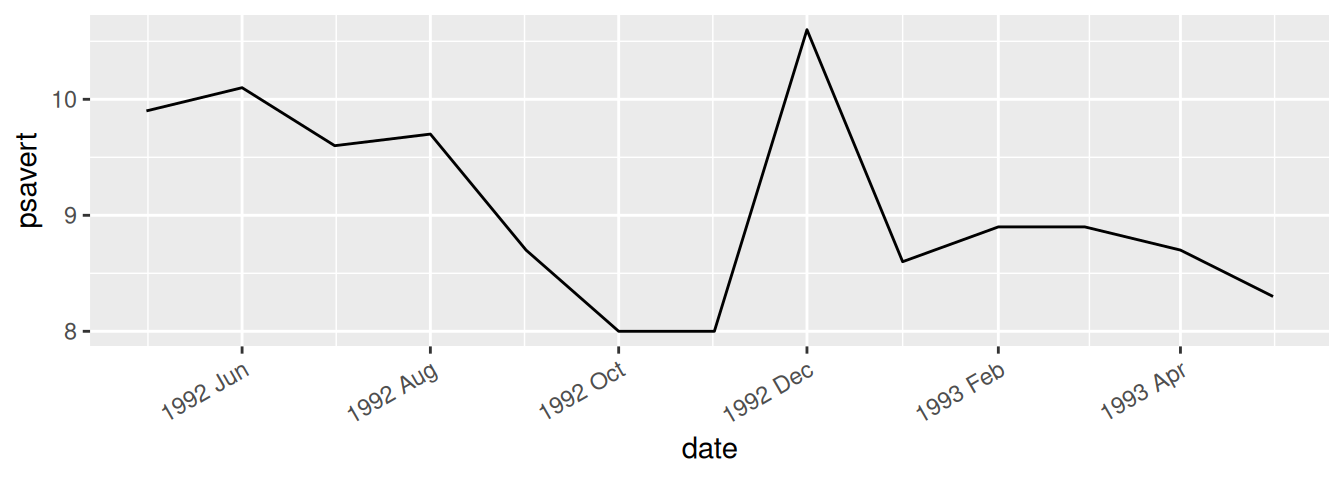8.17 Using Dates on an Axis
8.17.2 Solution
Map a column of class Date to the x- or y-axis. We’ll use the economics data set for this example:
economics
#> # A tibble: 574 × 6
#> date pce pop psavert uempmed unemploy
#> <date> <dbl> <dbl> <dbl> <dbl> <dbl>
#> 1 1967-07-01 507. 198712 12.6 4.5 2944
#> 2 1967-08-01 510. 198911 12.6 4.7 2945
#> 3 1967-09-01 516. 199113 11.9 4.6 2958
#> 4 1967-10-01 512. 199311 12.9 4.9 3143
#> 5 1967-11-01 517. 199498 12.8 4.7 3066
#> 6 1967-12-01 525. 199657 11.8 4.8 3018
#> # ℹ 568 more rowsThe column date is an object of class Date, and mapping it to x will produce the result shown in Figure 8.37:

Figure 8.37: Dates on the x-axis
8.17.3 Discussion
ggplot handles two kinds of time-related objects: dates (objects of class Date) and date-times (objects of class POSIXt). The difference between these is that Date objects represent dates and have a resolution of one day, while POSIXt objects represent moments in time and have a resolution of a fraction of a second.
Specifying the breaks is similar to with a numeric axis – the main difference is in specifying the sequence of dates to use. We’ll use a subset of the economics data, ranging from mid-1992 to mid-1993. If breaks aren’t specified, they will be automatically selected, as shown in Figure 8.38 (top):
library(dplyr)
# Take a subset of economics
econ_mod <- economics %>%
filter(date >= as.Date("1992-05-01") & date < as.Date("1993-06-01"))
# Create the base plot, which does not specify the breaks
econ_plot <- ggplot(econ_mod, aes(x = date, y = psavert)) +
geom_line()
econ_plotThe breaks can be created by using the seq() function with starting and ending dates, and an interval (Figure 8.38, bottom):
# Specify breaks as a Date vector
datebreaks <- seq(as.Date("1992-06-01"), as.Date("1993-06-01"), by = "2 month")
# Use breaks, and rotate text labels
econ_plot +
scale_x_date(breaks = datebreaks) +
theme(axis.text.x = element_text(angle = 30, hjust = 1))

Figure 8.38: Top: with default breaks on the x-axis; bottom: with breaks specified
Notice that the formatting of the breaks changed. You can specify the formatting by using the date_format() function from the scales package. Here we’ll use "%Y %b", which results in a format like "1992 Jun", as shown in Figure 8.39:
library(scales)
econ_plot +
scale_x_date(breaks = datebreaks, labels = date_format("%Y %b")) +
theme(axis.text.x = element_text(angle = 30, hjust = 1))
Figure 8.39: Line graph with date format specified
Common date format options are shown in Table 8.1. They are to be put in a string that is passed to date_format(), and the format specifiers will be replaced with the appropriate values. For example, if you use "%B %d, %Y", it will result in labels like “June 01, 1992”.
| Option | Description |
|---|---|
%Y |
Year with century (2012) |
%y |
Year without century (12) |
%m |
Month as a decimal number (08) |
%b |
Abbreviated month name in current locale (Aug) |
%B |
Full month name in current locale (August) |
%d |
Day of month as a decimal number (04) |
%U |
Week of the year as a decimal number, with Sunday as the first day of the week (00–53) |
%W |
Week of the year as a decimal number, with Monday as the first day of the week (00–53) |
%w |
Day of week (0–6, Sunday is 0) |
%a |
Abbreviated weekday name (Thu) |
%A |
Full weekday name (Thursday) |
Some of these items are specific to the computer’s locale. Months and days have different names in different languages (the examples here are generated with a US locale). You can change the locale with Sys.setlocale(). For example, this will change the date formatting to use an Italian locale:
# Mac and Linux
Sys.setlocale("LC_TIME", "it_IT.UTF-8")
# Windows
Sys.setlocale("LC_TIME", "italian")Note that the locale names may differ between platforms, and your computer must have support for the locale installed at the operating system level.